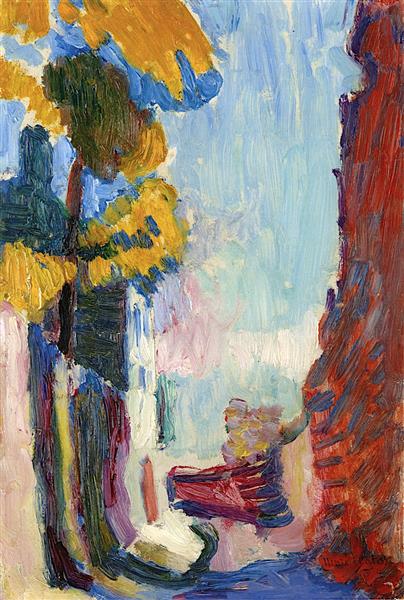Description
Henri Matisse, one of the most illustrious exponents of modern art, provides us with "Arcueil" (1899), a window into his stylistic evolution and his tireless quest for new forms of expression. This work, with its dimensions of 41x60 cm, encapsulates a crucial stage in the artist's career, a moment when he was deeply influenced by Impressionism and still forging what would later become his distinctive Fauvist style.
At first glance, "Arcueil" presents itself as an Impressionist study of the urban landscape of Arcueil, a commune located in the southern outskirts of Paris. The painting captures a panoramic view, possibly from a hill, with rooftops of buildings and a bridge standing out among the foliage. Matisse uses a relatively sober but vibrant color palette, dominated by the greens of the trees and the browns of the buildings, contrasted by the blue of the sky and the clouds that seem to move gently.
The technique employed by Matisse in "Arcueil" highlights his ability to manipulate the brush and create textures that suggest nature without the need for exhaustive detail. Here, the influence of the Impressionists is perceived, especially in the treatment of light and color. The short, loose brushstrokes, almost pointillist in some areas, allow the colors to blend optically, endowing the painting with intrinsic luminosity. This technique reflects a phase of experimentation, in which Matisse explores how to capture the visual essence of a fleeting moment.
Despite the apparent calm and simplicity of the landscape, "Arcueil" is a work rich in visual dynamism. The composition is carefully balanced, with the bridge acting as a central axis that guides the viewer's gaze through the painting. The different heights of the buildings and the vegetation add depth and perspective, creating an almost theatrical setting.
Although the scene lacks human figures, the constructed environment suggests activity and life. The red and brown roofs contrast with the greens, indicative of the coexistence between urbanization and nature. This play of contrasts is a constant in Matisse's work, which he would later develop in his renowned Fauvist works where color becomes the main protagonist.
It is interesting to note that "Arcueil" is situated in the context of the late 19th century, a time of significant social and artistic changes in Europe. Matisse, then in his thirties, was absorbing an amalgam of influences ranging from Cézanne to Neo-Impressionism, each of which left an imprint on his work.
In conclusion, Henri Matisse's "Arcueil" is not just a picturesque landscape but also a testament to a creative mind in full transition. Through this work, Matisse shows us his early forays into the dissolution of forms and the expressive use of color, a prelude to what would be his revolutionary contribution to modern art. The painting not only captures a place but also a crucial moment in the career of an artist who was destined to rewrite the rules of painting in the 20th century.

